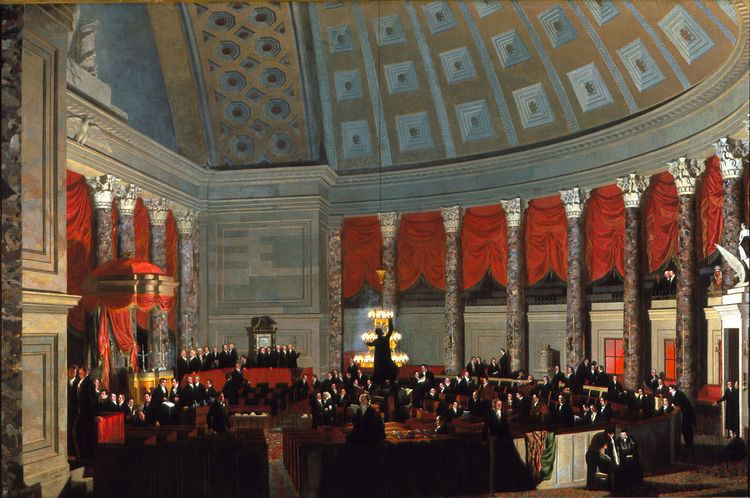 | ||
The Opposition Party was a party identification under which Northern, anti-slavery politicians, formerly members of the Democratic and Whig parties, briefly ran in the 1850s. This was in response to the expansion of slavery into the new territories. It was one of the movements which arose from the political chaos in the decade before the Civil War in the wake of the Compromise of 1850. The movement arose before and was quickly subsumed by the coalescence of the Republican Party in 1856.
During the fragmenting of the Second Party System of Jackson Democrats and Clay Whigs, the Democratic efforts to expand slavery into western territories, particularly Kansas, led to organized political opposition, which coalesced in Congress as the "Opposition Party." As the Whig Party disintegrated, many local and regional parties grew up, some ideological, some geographic. When they realized their numbers in Congress, they began to caucus in the same way US political parties had arisen before the Jacksonian national party conventions. Scholars such as Kenneth C. Martis have adopted a convention to explain the Congressional coordination of anti-Pierce and anti-Buchanan factions as the “Opposition Party”.
1854
In the Congressional election of 1854 for the 34th United States Congress, the new Republican Party was not fully formed, and significant numbers of politicians, mostly former Whigs, ran for office under the Opposition label. The administration of Democratic President Franklin Pierce had been marred by Bleeding Kansas. Northerners began to coalesce around resistance to Kansas entering the Union as a slave state. The ongoing violence made any election results from that territory suspect by standards of democracy.
The Opposition Party was the name adopted by several former Whig politicians in the period 1854-1858. In 1860, the party was encouraged by the remaining Whig leadership to effectively merge with the Constitutional Union Party.
It represented a brief but significant transitional period in American politics from approximately 1854 to 1858. For the preceding 80 years, one of the major political issues had been the battle between the pro-slavery and anti-slavery factions in the United States, which had been fought more on the basis of regional and class affiliations than strictly along party lines. However, the passage of the Kansas-Nebraska Act in 1854 fractured the Whig Party along pro- and anti-slavery lines, and led ultimately to the formation of the Republican Party, which strongly attracted anti-slavery Whigs and Democrats. For many, the Opposition Party served as a successor to, or a continuation of, the Whig Party.
The party was seen as offering a compromise position between the Southern Democrats and Northern Republicans.
The Whig name had been discredited and abandoned, but former Whigs still needed to advertise that they were opposed to the Democrats. The Know Nothings had found that its appeals to anti-immigrant prejudice was faltering and their secrecy was made suspect, so they sought more open and more inclusive appeals to broaden a candidate's chances at the polls.
The "confounding party labels among all those who opposed the Democrats" have led to scholars of U.S. political parties in Congress to adopt the convention "Opposition Party" for the 34th and 35th Congresses. This term encompasses Independent, Anti-know-nothing, Fusion, Anti-Nebraska, Anti-Administration, Whig, Free Soil and Unionist.
Following the 1854 election, the Opposition Party actually was the largest party in the U.S. House of Representatives. In the resulting 34th United States Congress, the U.S. House's 234 Representatives were made up of 100 Oppositionists, 83 Democrats, and 51 Americans (Know Nothing). That was a very dramatic shift from the makeup of the 33rd United States Congress (157 Democrats, 71 Whigs, 4 Free Soilers, 1 Independent, 1 Independent Democrat). Being the largest party did not lead to control of Congress; the new Speaker of the House was Nathaniel Prentice Banks, a former Democrat from Massachusetts who campaigned as a Know Nothing in 1854 and as a Republican in 1856.
By the 1856 elections, the Republican Party had formally organized itself, and the makeup of the 35th United States Congress was 132 Democrats, 90 Republicans, 14 Americans, 1 Independent Democrat.
